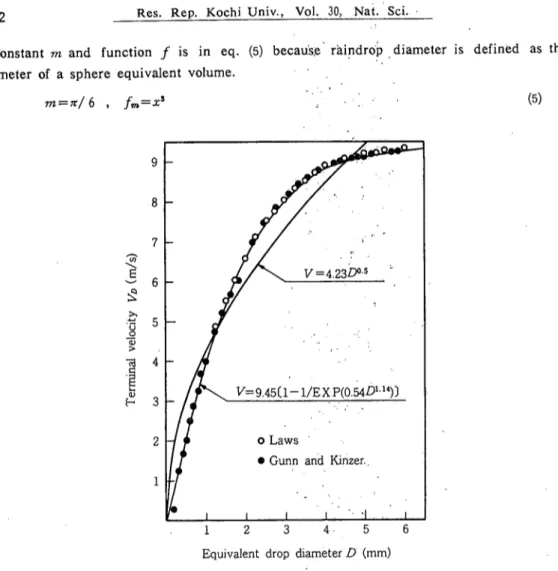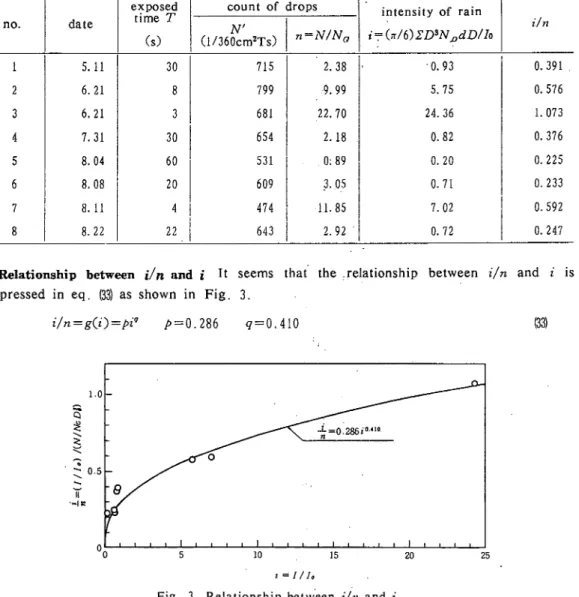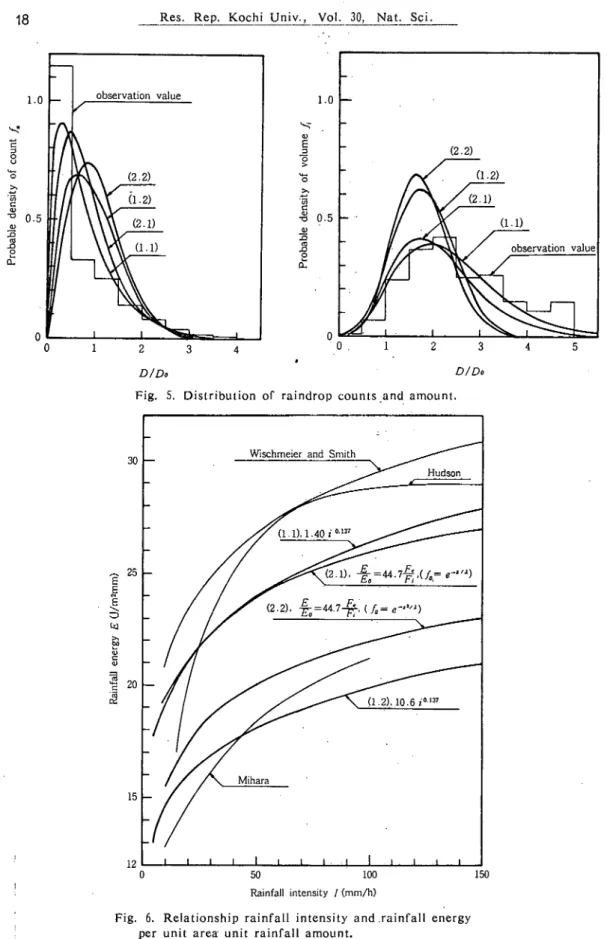Estimation
of the Rainfall Energy
Affecting on the Ground・
NOBUHIRO MINAMI and Masazumi OGURALaboratory of Land Conservation, Faculty cがAgriculture
Abstract : Many investigations on the terminal velocity of a,rain drop and the distribu-tion of raindrops with their diameters in a storm, are totally concerned in rainfall energy・ We proposed semi theoretical equations of rainfall energy refering above investigations and introducing the relationship that count of raindrops per unit area and unit time are shown in the function of rainfall intensity・
These equations are compared with the others rainfall energy.equations in Fig. 6. This paper is described as the basic research for the study of soil erosion by rainfall.
Introduction
The first stage in the process of soil erosion by a storm is in the splash erosion. In this stage, we will require the estimation of a rainfall energy to discuss on movement of soil particles.
Results of investigations on the terminal velocties of every raindrop diameters, drop size distribution in unit space have been published. Let us discuss above terms by turns.
Terminal velocity and mass of a raindrops
Terminal velocities of raindrops depending on their sizes are attained when the gravitatio-nal forces oh their drops are balanced the resistance forces of the air through which they are falling respectively.
Published reports by LawSI)and Gunn and Kinzer^) are representative on falling velocity of a raindrop. The former measured their velocities by camera and the latter done by electric charge method for oscillograph recorder. Their results of mea‘surment are in good agreement.
Terminal velocities of various size drops are plotted in Fig. 1 , where equivalent drop diameter is defined as the diameter of a sphere of equivalent volume.
A general equation on the relationship between relative terminal velocity y and veloctity function including drop size is expressed in eq. (l) Constants V and the function/, have been・
showed by Gunn and Kinzer2リneq. (2) simply. We will show them・ 1neq. (3) closely. y=り1 (1) り= 4..23' 几=jz7o●5 (2) フ■>=9.45 石=1 − 1 /EXP (0.54z1.14) (3)丿 where £)(mm):equivalent diameter Do=1(mm) ’yz,(m/S):terminal velocity yo=1(m/S) エ=DノDo フノ=ら/yo .
Mass of a raindrop Mn (mg) is expressed generally in eq. (4)・
Constant
77z and function j is in eq. (5) because raindrop いdiameter is defined as the diameter of a sphere equivalent volume.
m=7r/ 6 ,ふ=zs ⊃ ノ▽ ● (5) 9 8 7 < £ ) i n -^ C O ︵ S / U I ) O y \ A j p O l S A J B U I U U 9 J L 2 1 1 2 3 4一一 5 6 Equivalentdrop diameter D (mm)
Fig. 1. Terminal velocity of water・drops・ of defferent ・sizes in a stagnant air and representative curve by equatio瓦j へ
Count and amount distribution of r4血drops in unit space
We consider that in a continuous rainfall with constant iポensity, raindrops belong to in several classes of the range from (£)−j£)/2)t6▽(£)ナdD/1). which have representative diameter D respectively, and the origin of time 励d been defined the just time when a marking raindrop in each classes had landed on'the ground surface.
After the time pass in dt, those Nぶh raindrops 'jn ・each classes (£)土j£)/2) have been landed on the ground which is in unit area S. " 犬 ‘ ・
It seems that at the origin of time Z=O those iVnthかo恥y had eχisted upward from the ground surface in the space with the height of Ydt and raindrop flecks ofy counts have been made one after another by raindrops of N counts in the space・
According to this consideration, count density of raindrops in the space yoz,(m-3mm-1) is expressed in eq. (6) physically and eq. (7) mathematically。
e a S r 5 a a
㈲
1ろ NQ。= aNofo fo=\/EχP(か/λ) 〔7〕 where αj : constant, 7Vo=1(7n-> mm ^) λ:distribution factorゐ=1 by Marshall and Parmer" ゐ=2 by Shiotsuki'"
lf瓦。is defined in eq. (8), total count of raindrops jVJ(m-3)andthe probable count density function of raindrops /,, in the space are shown in eq. (9) and (1()。
F<Sn ゜ Jo几血 (8)
NJ=f77von dL)=yoDOFo,i (9)
偏=No。£),/NJ=石/Fo。 ぐ1(1
iS
二二で7でj≒yhith弛D土dDIl of the di“「Tieterrange in the space Mo°(「Tig/ 「゜“1」
M。=MbNoD=PJ^oZ:)o3mムダo 圓
de
lごここjjタップなeご
。
(1‰t:ゴごSs of moisture Aも(tng/ 「) and the probable moisture
F如、= J°゜み几心; 0 MJ= f°゜肩 oJ£)=pjvoDo’ ■maFn 、 0 几。= -W0J9£)/MJ=ふ几/Fo。
Count of raindrop flecks on the ground and rai皿fall intensity
If it is defined thalNoD{\lmm 「s).is count of raindrop flecks on the unit area of ground during unit time in the range Zニ)±dD/2 0f the raindrop size, we obtain eq. tt5).
No。=N。Z(SdはL))=Noz,ら=yo7Voり可Jo 回 If F, is defined in eq. (16),total count of raindrop flecks N(1/m2S)and probable count density function of them are shown as eq.(17) and C18)。
几=j`゜O 几石血 旧
iV=Fcμoz:)四几 聞 fヶ,= NouI-:)/N=fJo/几 m
Total volume of raindrops landed during unit time‘on the unit area ・of ground means rainfall intensity /(mmV 「s), therefore amount density of rainfall ら(mm2/m2S)iS shown in eqバ19)。 乙=MdNqd/P。=VoNoL:)0^mvafmfJo 叫
If Ft is defined in eq. (20)rainfall intensity 7 and probable amount density function 五 are shown as eq. 闇and (22)。
J
0ペ添)血
7=L
/<=/^f,ふ/F。
Hence, from eq. iXD and (21], eq. (23) will be born.
I/NDo3=琲F,/Fn
I 闘
(22)
(23)
If /o=(mm/h)
and Na=\(1/mmh) are defined, / and
N
are measured
by those units
non dimensional numbers
as eq. (24)are producted.
i = I/Io 、71=N/No
Eq. (24) is rewriten as eq. (25). 百加=mFも/Fn
(24)
闇
If observed values of (φT.} are shown in the ・function e-(0, which have only one variable (0,・eq.・(25)is exchanged to eqバ26) which will show the relationship between f and λ.
g(0 = mF4/F。=人λ)
闘
Rainfall energy
li El,’(10-6J/ 「mm)is defined as the rainfall energy affecting on the unit area of ground in each raindrop size range (£)±dDIl) during unit time, it is as eq. 飢
£y=Mz,yjy2,/2===pt。Fo'NoDo’mij'af^fjo (27)
When the rainfall energy per unit area and unit rainfall intensity is defined as £o instead of eq. 囲.
£.=EjZI=(らyo2/2Do)vHr.fJo/瓦 雛 If F, is defined as eq. (29), total energy E (J/m'mm) affecting on the unit area of ground
per unit rainfall intensity and probable density function of the energy /≪ are shown as eq. 閤and (3D. ダ.
F。=J゛フムLhdx
£=fy£J£)=£002/2)瓦/几
石=ふ几3几/F,
Where E,=ρぶ
Definite
integral values
In this paper. four kinds of basic functions have been used as Table l
S5
^
EJ
22
15
1.0 2.0
Tabχe: V. Combination of basic functions
combination function is defined as (j、k)
Definite integral values of combination
functions in. two cases「1」)
and (1。2)
can; be
obtained in Gamma
function with parameter
λas in Table 2.
In the other cases (2.1) and (2.2), those
values were obtained by Newton
・Cotes.・nu-merical inte!grationmethod
with several λ.
Relationship between those values and λ
is shown in Fig. 2.
5.0 1.0 ︱ g n f E A [ B i s a i u i J i u i j s n Table l, Values of F。, Et, and F6. ノ / 〆 (2.1) / g /づ
// / / / / / / / / //
/ //
1 ノ /ド
p
/ / / / / / / //
/
/
/
//
/ f / j / / / / / / 0.003 1- 0.1 5.0 1.0 0.1 0.01 (2.2) | / ///
//
y / が ン/
/ / / / / rノ −/、 / , ノ ? /ノ //
/
//y
ル
ダ
/
r / / / / / / r 0 0 00?i λ Å Fig. 2. Definite in:tegral va]ues and λ.2 0 25
Results of observation and discussion
Equivalent diameter of a raindrop Members in the Laboratory of Agricultural Meteoro-logy of Kyushu University have used the calibrattion curve t`o estimate the equivalent diameter from a fleck diameter D/ of a raindrop landed on the filter paper soaked Methylene Blue. ゛
This calibration curve is expressed in eq. (32).
x=0.305(Z:)r/Do)゜●78 ¨ (32)
Observation data We counted raindrop flecks on the filterpaper in 18cm X 20cm area. This paper had been offered from Kyushu University and we calculated equvalent diameters by eq. (32》.Data are in Table 3。
Tab\e 3. Observationdata i,1 1981
no.
date
exposed
time 7
(S)
count of drops
intensity of rainiヲ(π/6)Σ£)5N≪dD/Io
i/n
y (1/360cm2Ts)n=N/N。
1 2 3 4 5 6 7 8 5.11 6.21 6.21 7.31 8.04 8.08 8.11 8.22 30 8 3 30 60 20 4 22 715 799 681 654 531 609 474 643 2.38 ,・9.99 22. 70 2.18 0:89 3.05 ↓1.85 2.92 1 , ・0.93 5.75 24.36 0.82 0.20 0.71 7.02 0、n 0.391 , 0.576 1.073 0.376 0.225 0.233 0.592 0.247Relationship between i/n and i It seems that the relationship between φz and i is expressed in eq. (3l as shown in Fig. 3.
φz=g(0=μ9 i!> = 0.286 9 = 0.410 (33) ︵ t a ^ N / N ︶ / ( ≫ / / / ) = ? 1.0 0.5 0 0 5 10 15 t=□1。
邨; t;│≪> ヽ卜 1 0 1 0 . 1 17
The relationship will suggest that average volume of a drop increase proportionally to the 9 th power of rainfall intensity.
Therefore in cases (1.1) and (1.2) values of \ are obtained from eq. (34)and 05). λ=〔(6/π)(r,.Jr4.5)が9y3 闘 λ=〔(6A)Cro.75/r2.25>!゜〕2/3 (35) In the other cases (2.1) and (2.2) values of λare obtained graphycally in Fig. 4.
-(2.1)-| 1
ぷ
/ |聊
九
才
y
/
ノ〆 〆 50 20 10 司 絢 5 2 / / | 〆研
/ 〃 ノ f/
f ’ / 1 / ̄ ̄ f ’/
j−/ 「 − -4ル
/
Z j | が | // 1//
7
/ 0.01`− 0.1 1。0 λ 3.0 1 0 1 0.1 0.01 -(2.2) / ノ 1 「 | ・ //
∠
/
/
/ 〃 〆 〆 J 〃 ’ 50 20 10 1Q へ 哨 5 2 /−ジ
づ
/ ノ 〃 ’ | ノ − ’ / ● I才
/ //
〆 〆/
乙 -4 / / / Z、 / /ぷX・、/Å.八
1ダy
0 . 1Fig. 4. Graph for j and E/Eo.
1。0 λ
3.0
Count and amount distribution of raindrops Let compare with observation values and calculated values on probable density of raindrop counts /n and intensity of rainfall fi. An example is picked up in Fig. 5.
Energy equation We will obtain energy equations from eq. (30),(34),(35)and Table 2 in two cases (1.1) and (1.2).
E/Eo=(が/2)cr5.5/√'4.5)〔(6/π)(r,.5/r4.5>'゜〕I/3=14.0f0.1ai (36) E/Eo=(りV2)(r2.75/r2.25)〔(6/π')Cro.is/r2.'is^pi゜y3=10.6z`0.137 (37)
The other cases £/£o are obtained in Fig. 4.
0n the relationship between rainfall energy and rainfall intensity several papers had been published.・
1.0 ″ り 0 / l u n o o 1 0 X ; i s u 3 i ︶ a t Q E ︵ 一 〇 J d 0 0 1 2 D/Do 3 1.0 0 1 5 ﹄ 7 s u i n i O A 1 0 A j i s u a p g t Q E Q O j j 0 4 0 1 2
Fig. 5. Distribution of raindrop counts and amount.
3 0 2 5 2 0 ︵ 日 日 Z U J / f ︶ 3 A 3 j a u a r i E i u r e y 15 12 3 D/Do 0 50 100 Rainfallintensityバmm/h)
Fig. 6. Relationship rainfall intensity and rainfall energy perunit area・ unit rainfall amount.
150
19
The eq. (38) had been proposed by Wischmeier and Smith'' which is famous for the element of rainfall factor to predict annual soil erosion loss from farm land.
E'Cst・foot/acre・inch) = 916 + 3311og /' (inch) (38) Exchanging to metric system it become eq. 閤.
E/E0 = 0.02636£'=8.725(1.363+log O G9) Other investigator's results" translated into numerical equations from those graphical curves are as follows;
Hudson E/Eo=29〔1−1/EXP〔0.2 0o.e2〕 Ker E/£o=13.5 j0.12
Mihara E/£o=8.0 ;o.2i
Our estimation values of、rainfall energy are shown in Fig. 6 with other investigator's results.
Conclusion
From the distribution of raindrop counts and amounts, two equations in the. cases (1.1) and (1.2) will express observation data. On the rainfall energy, it seems that the equation in the case (1.1) showed approximately simlar to resuls in the case (2.1). And in the other cases (1.2) and (2.2), equations are expressed loosely Mihara's results。
As the conclusion, we consider that our equations should be used depending on each considerations, for example, simplicity, logicality or a substitute of other investigator's equations.
References
1) Laws, J. O., Measurments of the fall-velocity of water-drops and rain drops, Trans.Ainer. Ceopりs.Union,22, 709―721,(1941)
2) Gunn, R. and G. D. Kinzer, The terminal velocity of fall for water droplets, J. Iぼet., 6, 243―248, (1949)
3) Marshall, J. S. and W. M. Parmer, The distribution of raindrops with size, J. Met., 5, 165―166, (1948)
4) Shiotsuki, Y., On the flat size distribution of drops from convective rainclouds, J. Met. SocJ apan.51, 42―60, (1974)
5) Wischmeier, W. H. and D.D. Smith, Rainfall energy and its relationship to soil loss, Trans. Amer, Geoがりs,JJni・m,39(2), 285-291, (1958)
6) Smith, D.D. and W. H. Wischmeir , Rainfall erosionAdvances i71 Agronoi。^y,U. 109-148, (1962)



